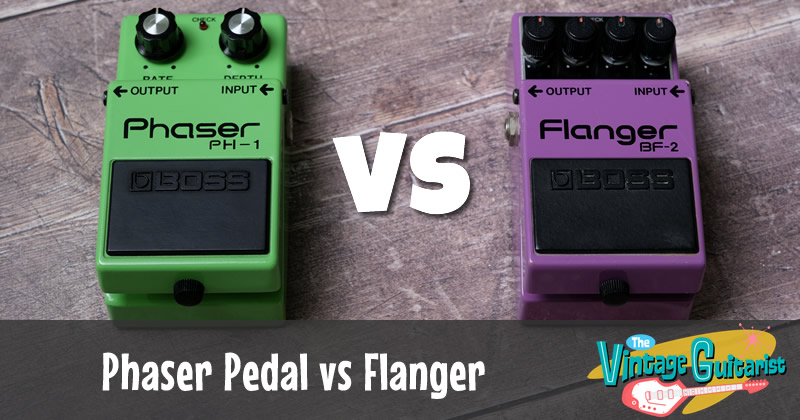Phaser and flanger pedals are two types of modulation effects used by guitarists. They are still popular today but were extremely popular in the 1970s.

From psychedelic sounds to something more subtle, both flanger pedals and phaser pedals offer you, as a guitar player, something that is great fun to use.
These electric guitar pedals have some basic similarities but have their own unique properties and qualities. Let’s look at what they do and how they differ.
What Are the Key Differences Between Phaser vs Flanger?
While both pedals produce similar results, they do so in different ways. Phasers use a series of filters to create an effect known as “phase cancellation.” This gives the guitar a “swirly” sound. Flangers, on the other hand, use a short delay to create a “whooshing” sound some would describe is like a jet engine taking off.
How Does a Phaser Pedal Work?
A phaser takes the input signal and splits it in two identical audio signals. One is taken and processed by an all-pass filter and phase shifted by modulating the frequencies using an LFO (low frequency oscillator).
These are then out of phase with the unaltered dry signal that they are mixed back with.
The end result is the swirling phaser effect. It’s similar but more pronounced than a chorus effect.
How Does a Flanger Pedal Work?
Flanging takes its name from a popular studio practice pioneered during the 1960s. An identical signal was recorded on two tape recorders that are synchronized. These were then played back and re-recorded. While this was happening a studio engineer would push down on the flange (outer edge) of one of the reels slowing down one of them causing a delay. As the spool caught up, you’d get the flanger sound.
These days we don’t need to do tape flanging as it’s all handled electronically. The audio signal is split in two. One is then processed with a varied delay time (around 20 milliseconds) and the delayed signal mixed back with the original signal.
A flanger is not too dissimilar to a phaser but offers an even more pronounced effect.
Modulation Briefly Explained
Modulation based effects include pedals such as; chorus, flanger, phaser, tremolo and vibrato. But what exactly is modulation?
In terms of effects, modulation is basically any parameter that alters the signal over time. It can alter the waveform by:
- Pitch
- Volume
- Filters / blending two waveforms back together
Signal processing could be a single one on of these or a combination.
Conclusion
On the surface these effects share some similarities and can even be made to sound quite similar on lower settings. However, when you crank up the controls, they sound very different.
Used sparingly they can add some lovely texture to your playing. Turn up the controls and they give a unique sound that can define a song.
